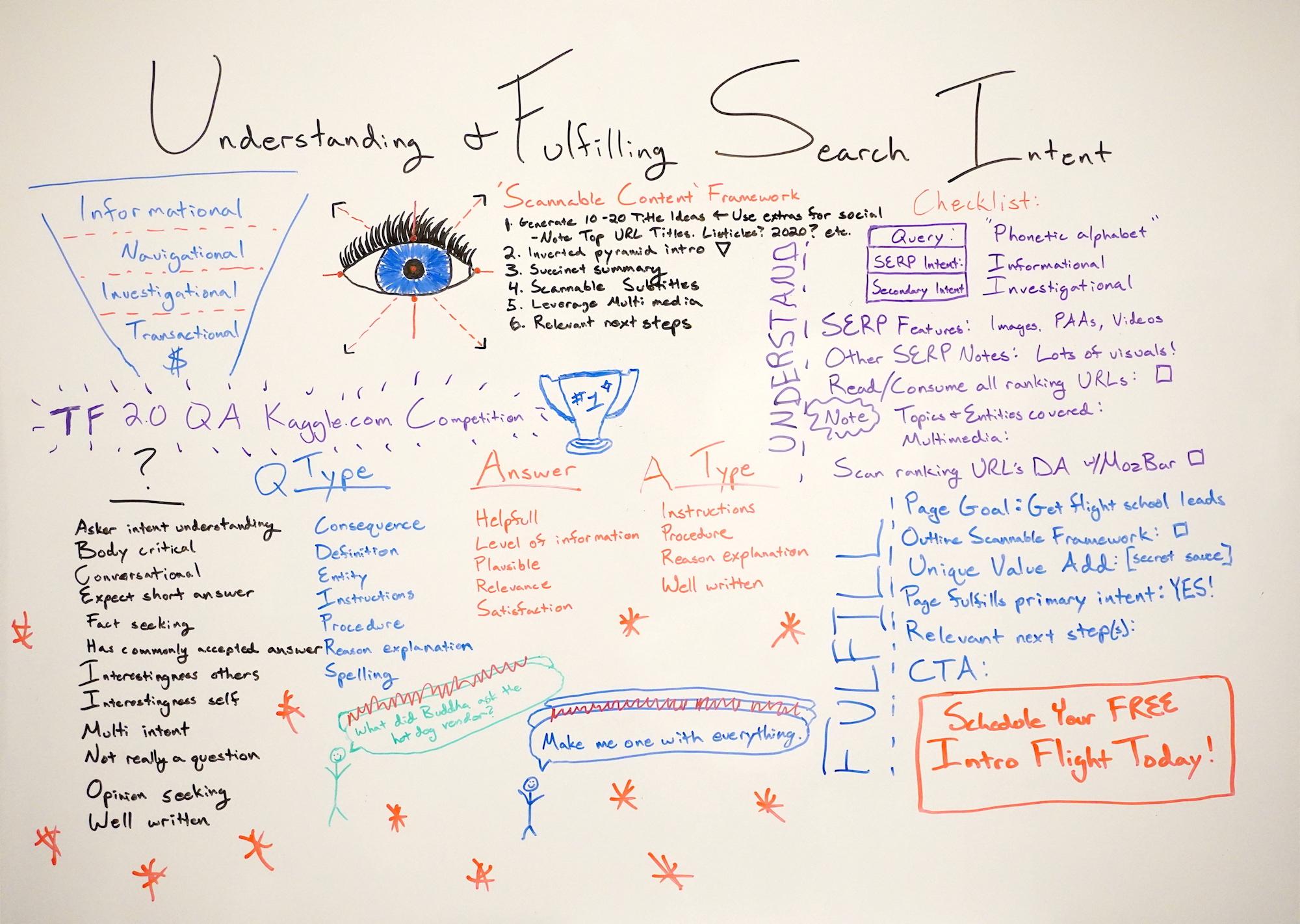
Understanding & Fulfilling Search Intent
Google houses the world's information, and it's their goal to serve the best answers to searchers' questions. That means that understanding what your target audience is searching and why is more important than ever — but how do you effectively analyze and fulfill true search intent?
In this brand-new Whiteboard Friday, Britney Muller shares everything you need to begin understanding and fulfilling search intent, plus a free Google Sheets checklist download to help you analyze the SERPs you care about most.

Click on the whiteboard image above to open a high-resolution version in a new tab!
Video Transcription
Hey, Moz fans. Welcome to another edition of Whiteboard Friday. Today we're going to be uncovering understanding and fulfilling search intent, and this is a really important topic to understand and better prepare your content around.
I want you to think about this idea that Google houses the world's information. They very likely know what the majority of people searching X are seeking, and they're going to continue to get better and better and better at that.
Understanding search intent
What I would suggest you do and what you arm yourself with is this idea of really leaning on Google to better understand the intent behind any given search. You're probably very familiar with the informational, navigational, investigational, and transactional-related intent types, and you can pull this information, like I said, directly off the SERP.
Analyze: informational, navigational, investigational, transactional?

You're probably very familiar with the informational, navigational, investigational, and transactional-related intent types, and you can pull this information, like I said, directly off the SERP.
- Is there a featured snippet?
- Is there a knowledge graph? You can pull that sort of information.
- Are there site links?
- Is it navigational in nature, people just trying to go to one destination?
- Is there a comparison table?
- Are they perhaps investigating?
- Transactional, are there tons of ads?
- Are there lots of product pages showing up in the results?
- Is there a shopping carousel?
You can pull intent types directly from the search. What's interesting though is any given SERP doesn't necessarily have one intent type.
In fact, it likely has a couple of nitty-gritty intent types that Google themselves haven't quite totally figured out. I want to pull back the curtain on how Google is actively trying to get better at understanding intent within questions and answers within content.
They put up a competition to a bunch of data scientists to determine if anyone could build a model that can accurately weight these various intents with the content.
Question information
There's question information that they wanted the model to predict around: Is this fact-seeking? Does it have multi-intent? Is it not really a question? That's my favorite. Is it well-written?
- Asker intent understanding
- Body critical
- Conversational
- Expect short answer
- Fact-seeking
- Has commonly accepted answer
- Interestingness to others
- Interestingness to self
- Multi-intent
- Not really a question
- Opinion-seeking
- Well-written
Question type
Then they're also trying to understand the type of question. Is it a definition? Is it instructions? Is it spelling, which is most of my searches?
- Consequence
- Definition
- Entity
- Instructions
- Procedure
- Reason explanation
- Spelling
Answer information
Then they get into answer information. Is the answer intent helpful? Is it plausible? Is it relevant? Does it satisfy the question?
- Helpful
- Level of information
- Plausible
- Relevance
- Satisfaction
Answer types
They even drill a bit deeper into answer types. Is it instructions, procedure, well-written?
- Instructions
- Procedure
- Reason explanation
- Well-written
Again, you see these sort of themes occur. So it's important it's not just these four. It's great to know these and sort of run with them a bit. But put these in your back pocket and know that it goes a lot deeper and it's a lot more complicated than that.
Search Intent Checklist
Let's dig into this checklist of sorts. The idea behind this is that there's a Google sheet that you can have today, make a copy and tweak however you'd like, that walks you through really this first process of understanding the intent and then fulfilling it.
Make a copy of the Search Intent Checklist
Once you do this a couple of times, you're not going to need this checklist. This will become second nature to you. Let's just walk through what this looks like.
1. Uncover the SERP intent

First, what is the primary SERP intent? For my example, I have phonetic alphabet, informational. Secondary intent might be investigational for the types of content people are looking for.
2. List any SERP features and other SERP notes
I list the SERP features that I notice in the search results. I'm really just making mental notes of what I'm seeing. So for this particular SERP, there were a lot more visuals than I expected, and so I made note of that. That kind of surprised me. I also made note this is the order of the features that are showing up.
3. Read, consume, and take notes about the ranking URLs
The next thing you do is to read and consume all of the ranking URLs. This is so, so important if you're serious about ranking for a particular keyword. You should actively be consuming this content and making notes about topics and entities covered.
- What sort of multimedia are they using?
- What are the layouts?
- What does it feel like?
You can really start to have a better checklist of what does that content look like and what are those expectations.
4. Scan ranking URLs' Domain Authority with MozBar
Then, ooh, my favorite secret hack is to activate MozBar for the search result page. You can see the Domain Authority and the backlinks for every single URL on a SERP.

A lot of people don't know you can use MozBar directly within Google search results, and it's fantastic. What I use this for, if I want to rank for something like this, I would just evaluate all of the organic DAs, and I would really evaluate that range and see if the website or my client's website might be competitive with it.
If they're not even close, maybe I pivot this and I try to target something more appropriate for them to rank for in the short term.
Fulfilling search intent
Now the fulfill part, are you fulfilling this intent?
Page goal
What is the page goal? Every page should have a goal.
Outline scannable framework

I want to just briefly explain what I mean by this. Scannable content is so, so important. More and more people are on mobile. Our attention span is getting shorter and shorter.
1. Generate 10–20 title ideas and use the extras for social
This idea that you should generate multiple title ideas to come up with the best one, but then use the others for social media. Shout-out to Andy Crestodina, who came up with that, which I love.
2. Use the inverted pyramid
Use the journalistic style where you tell people the most important information at the top.
3. Succinct summaries
Make sure you have succinct summaries. Omit needless words, whether that be at the top or at the bottom of your content. It's so important to have. Google loves pulling that information for things like featured snippets.
4. Scannable subtitles
Make sure you have scannable subtitles. Copyblogger does this beautifully, where you can just scan one of their articles and you quickly understand what the content is about like that. That's incredibly helpful for users.
5. Leverage multimedia
There's no reason why you couldn't also take a piece of content you're working on and provide other options or other forms for your visitors to consume it. We don't know what any given visitor might be or the position they're in to consume content at that time.
Maybe they're going for a walk and they want to hear audio. It's really great to provide different media types.
6. Provide relevant next steps
Then lastly, I have this here and here, are you providing relevant next steps? So I really thought about this for someone searching phonetic alphabet that are looking for information.
What might be relevant next steps? It sounds like they're sort of in a learning mode. So why not quiz them on it? Why not entice them to learn more about aviation jargon and language? You can start to like put yourself in the mindset of the user and really try to cultivate logical next steps for someone to go through on your site, so really building out that supportive content.
Make sure you have a CTA
Then lastly, make sure you have a CTA. Hopefully, it's to fulfill the page goal that you set for yourself. But ideally this should become second nature after a couple of passes, where you just have these kind of mental checks in your head and you can quickly and better evaluate search result pages to target and rank and succeed in search.
I really look forward to hearing your thoughts and your comments down below. Thank you so much for joining me on this edition of Whiteboard Friday. I will see you all soon. Thanks.



![How We Increased a Client’s Leads by 384% in Six Months by Focusing on One Topic Cluster [Case Study]](png/content-bd475af_2021-04-16-0003362130.png)
Comments
Please keep your comments TAGFEE by following the community etiquette
Comments are closed. Got a burning question? Head to our Q&A section to start a new conversation.